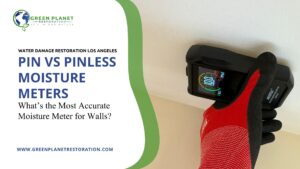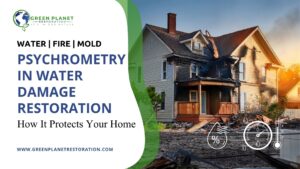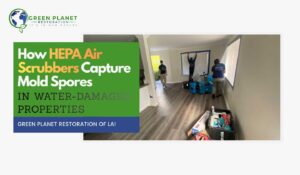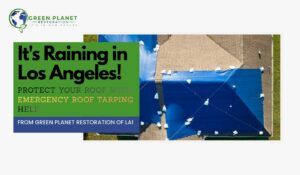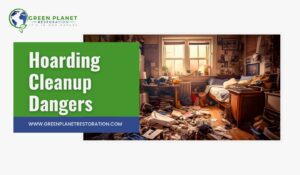Are you worried about hidden moisture wreaking havoc after a flood? Do you fear mold growth, warped floors, or structural damage long after the initial cleanup? When water invades your property as a result of either a burst pipe, heavy rainfall, or an appliance failure, the visible mess is only part of the problem. The real danger often lies in what you can’t see: residual moisture trapped in porous materials and behind walls. This lingering dampness doesn’t just delay restoration – it triggers secondary damage that can silently destroy drywall, warp hardwood, corrode wiring, and fuel toxic microbial growth (mold). That’s where LGR dehumidifiers prevent secondary damage and prove indispensable in modern water damage restoration.
At Green Planet Restoration Seattle, WA, we deploy industrial-grade Low Grain Refrigerant (LGR) dehumidifiers, which are built to achieve almost zero-level humidity. From reducing vapor pressure in hygroscopic building materials to inhibiting mold spores before they activate, LGR technology creates the stable, dry conditions needed to restore your property safely and completely.
Today, we will break down how LGR dehumidifiers outperform traditional systems, the science behind their moisture removal, and why they are the frontline defense in preventing costly secondary issues in water-damaged homes and commercial buildings.
Got a burst Pipe? Here’s our 24 Hour Plumbing Emergency Guide.
What is Low grain Refrigerant (LGR)?
Low Grain Refrigerant (LGR) dehumidifiers focus on water-damaged areas that need thorough drying. LGR dehumidifiers have a two-stage cooling system and better heat exchange than refrigerant ones. LGR dehumidifiers prevent secondary damage by removing humidity better than standard units. Even with low humidity, this water damage restoration equipment removes moisture from the air. Therefore, they are important to any water damage restoration process. Here are a few uses of LGR dehumidifiers to avoid secondary damage.
Should you file insurance claim for Water Damage? Learn here about the claims process filing here: File insurance claim for Water Damage
Lowering Vapor Pressure to Protect Hygroscopic Materials
High-vapor-pressure things like moist objects naturally release water vapor into the air. Air pressure must change significantly for a dehumidifier to dry items faster. LGR machines lower absolute air humidity to very low levels.
Hygroscopic materials, including wood studs, OSB, drywall, insulation, and underfloor systems, can better shed water due to this differential. If the ambient vapor pressure isn’t decreased rapidly, these materials will retain water longer, causing structural deformation.
- Warping or bowing frame.
- Cupped hardwood floors
- Board and composite panel cracks
- Breaking gypsum products
LGR dehumidifiers dry materials to their internal moisture level without drying them off too quickly, which could trap moisture.
(Weinbrecht, 2018; ASTM International, 2016)
Want to know What is the Difference Between Flood Damage and Water Damage? Read our blog: Flood Damage Cleanup vs. Sewage Damage Cleanup
Achieving Grains Per Pound (GPP) Below 34
The grains per pound (GPP) is a standard unit of measurement for air moisture content in water damage restoration. It represents the number of water vapor grains present in one pound of dry air. Once humidity levels drop below 50 GPP, traditional refrigerant dehumidifiers typically stop working.
(IICRC, 2021, Appendix C; National Air Duct Cleaners Association [NADCA], 2021)
However, depending on the surrounding conditions, LGR dehumidifiers prevent secondary damage and can maintain GPP levels as low as 32 or even lower. This capacity matters when attempting to return porous materials to their equilibrium moisture content (EMC), especially in situations where deep moisture has saturated hidden structural cavities.
By keeping the GPP below 34, technicians can achieve their drying targets more efficiently, without risking damage from excessively aggressive heat or airflow. It also helps prevent:
- Secondary cracking from uneven drying
- Problems with the bonding of glued surfaces (such as tiles or flooring)
- Paint and coating flaking or bubbling
Do you have an ice maker in your home? If so, there is a good chance that it has leaked at some point. Learn how to deal with a Leaking Ice Maker.
Inhibiting Microbial Amplification
Mold spores, bacteria, and fungus multiply quickly in environments where the relative humidity (RH) stays over 60% for more than a day or two. When colonies become active, they can ruin the air quality, harm porous materials, and even impact the building’s habitability in the long run.
Even in extremely saturated settings, LGR dehumidifiers are excellent at reducing humidity after water damage (RH) to 30 – 40%, which effectively suppresses microbial activity. Swiftly lowering the environment below the point where microbes may proliferate is their goal.
- This not only stops active growth but also prevents:
- Germination of dormant mold spores
- Mycotoxin amplified with allergic effects
- Spread of bio-contaminants in HVAC systems and wall cavities
When installed early in the drying process, LGRs manage ambient conditions and can reduce the need for expensive mold cleanup.
Also read: What Does Certified Mold Testing Do?
Preventing Secondary Chemical and Corrosive Reactions
Chemical reactions cause materials to degrade in humid settings, even if the effects aren’t noticeable at first. Some examples are:
- Damage to tiles and flooring due to the hydrolysis of some adhesives
- Damage to HVAC parts, electrical panels, and metal connections in the structure due to corrosion
- Steel reinforcement bars or frame oxidation in concrete
- Combustion of insulation, sealants, and vapor retarders
To stop these reactions in their tracks, LGR dehumidifiers prevent secondary damage by rapidly lowering the concentration of moisture vapor. In both commercial and residential buildings, this protection is crucial because high humidity can speed up the failure of sensitive materials, including HVAC coils, coated electrical wiring, and metal fasteners.
Did sewage or floodwater soak into your drywall? Learn Why You Must Replace Sewage-Damaged Drywall And How to Do It
Stabilizing the Psychrometric Environment

The consistent removal of moisture from different materials depends on a well-controlled drying environment. Green Planet Restoration Seattle experts can control a wide range of psychrometric variables with LGR equipment, including:
- Dry bulb temperature impacts evaporation energy.
- Surface condensation potential can be estimated using the dew point.
- The flow of moisture from moist materials is driven by the vapor pressure differential.
- The air’s ability to retain more moisture depends on its relative humidity and its GPP.
By maintaining a controlled psychrometric profile, LGR dehumidifiers ensure:
- Even moisture distribution across surfaces and within cavities
- Prevention of over-drying or cracking of finish materials
- Compliance with IICRC S500 drying standards, which emphasize measurable results
They help restorers avoid under-drying (microbial hazards) and over-drying (material stress).
(Institute of Inspection, Cleaning and Restoration Certification [IICRC], 2021, Section 12.4.3)
Final Words
Without an LGR dehumidifier and moisture mapping services seattle, no professional drying operation is complete. LGR dehumidifiers prevent secondary damage after water intrusion by creating low vapor pressure and removing deeply trapped moisture. They also help stop mold growth and keep indoor conditions stable during the drying process. To discuss your restoration needs and find the proper moisture management solution for your individual requirements, reach out to the experts at Green Planet Restoration for water damage restoration Seattle today.
___________________
Related Posts
Complete Guide to Crawl Space Maintenance and Cleanup
24 Hour Plumbing Emergency Guide
How LGR Dehumidifiers Prevent Secondary Damage
How Moisture Meters Prevent Mold Growth
Leaking Ice Makers: Why They Happen and How to Prevent Them
How To Handle Flood Damage in Southern California
Should I File an Insurance Claim for Water Damage?
8 Common Causes of Household Water Leaks and Water Damage
Psychrometry in Water Damage Restoration: How It Protects Your Home
Pin vs Pinless Moisture Meters: What’s the Most Accurate Moisture Meter for Walls?




